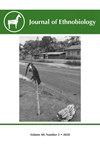Human Food Dynamics in Highly Seasonal Ecosystems: A Case Study of Plant-Eating in Riverine Communities in Central Amazon
IF 1.3
3区 社会学
Q1 ANTHROPOLOGY
引用次数: 0
Abstract
Abstract. Food habit studies in the Amazon emphasize the consumption of fish and manioc (Manihot esculenta) flour as basic diet in different ethnic groups, while little is known about human plant-related diet dynamics during the hydrological regime. In a scenario of food transition in rural Amazonia, with insertion of industrialized items in the diet, traditional food and consumption of regional products have undergone transformations, affecting the autonomy and lifestyle of traditional populations. Considering this, the objectives of the current case study were: (1) to contextualize plant-related eating habits in five Riverine communities on the Lower Purus River and (2) to characterize the dietary dynamics of plant eating according to the hydrological regime, considering the provenance of food items. We conducted interviews and sample collection in both low- and high-water seasons. We calculated species richness and diversity per meal and season and used multivariate analysis to access differences in plant consumption between seasons. The greatest richness and diversity of plants is consumed in the flooding season and mainly as snacks, the meal most susceptible to being replaced by industrialized foods. Despite a significant difference in diet between seasons, the basic array of plants consumed is similar in both seasons, with availability topped up by external purchases. This tendency deserves attention and action from public policies aimed at providing food security in the region.高季节性生态系统中的人类食物动力学——以亚马逊中部河流群落的植物食性为例
摘要亚马逊地区的饮食习惯研究强调,鱼类和木薯粉是不同种族群体的基本饮食,而对水文期间与人类植物相关的饮食动态知之甚少。在亚马逊农村粮食转型的情况下,随着工业化食品在饮食中的加入,传统食品和地区产品的消费发生了变化,影响了传统人口的自主性和生活方式。考虑到这一点,当前案例研究的目标是:(1)将普鲁斯河下游五个河岸社区的植物相关饮食习惯置于背景中;(2)根据水文状况,考虑到食物的来源,描述植物饮食的饮食动态。我们在枯水期和枯水期都进行了访谈和样本收集。我们计算了每顿饭和每个季节的物种丰富度和多样性,并使用多元分析来了解不同季节植物消耗的差异。植物的丰富性和多样性最大的是在洪水季节食用的,主要是作为零食,这种食物最容易被工业化食品取代。尽管不同季节的饮食有显著差异,但两个季节消耗的基本植物种类相似,外部购买增加了可用性。这一趋势值得旨在为该地区提供粮食安全的公共政策关注和采取行动。
本文章由计算机程序翻译,如有差异,请以英文原文为准。
求助全文
约1分钟内获得全文
求助全文
来源期刊

Journal of Ethnobiology
Social Sciences-Anthropology
CiteScore
4.80
自引率
3.40%
发文量
21
审稿时长
>12 weeks
期刊介绍:
JoE’s readership is as wide and diverse as ethnobiology itself, with readers spanning from both the natural and social sciences. Not surprisingly, a glance at the papers published in the Journal reveals the depth and breadth of topics, extending from studies in archaeology and the origins of agriculture, to folk classification systems, to food composition, plants, birds, mammals, fungi and everything in between.
Research areas published in JoE include but are not limited to neo- and paleo-ethnobiology, zooarchaeology, ethnobotany, ethnozoology, ethnopharmacology, ethnoecology, linguistic ethnobiology, human paleoecology, and many other related fields of study within anthropology and biology, such as taxonomy, conservation biology, ethnography, political ecology, and cognitive and cultural anthropology.
JoE does not limit itself to a single perspective, approach or discipline, but seeks to represent the full spectrum and wide diversity of the field of ethnobiology, including cognitive, symbolic, linguistic, ecological, and economic aspects of human interactions with our living world. Articles that significantly advance ethnobiological theory and/or methodology are particularly welcome, as well as studies bridging across disciplines and knowledge systems. JoE does not publish uncontextualized data such as species lists; appropriate submissions must elaborate on the ethnobiological context of findings.
 求助内容:
求助内容: 应助结果提醒方式:
应助结果提醒方式:


